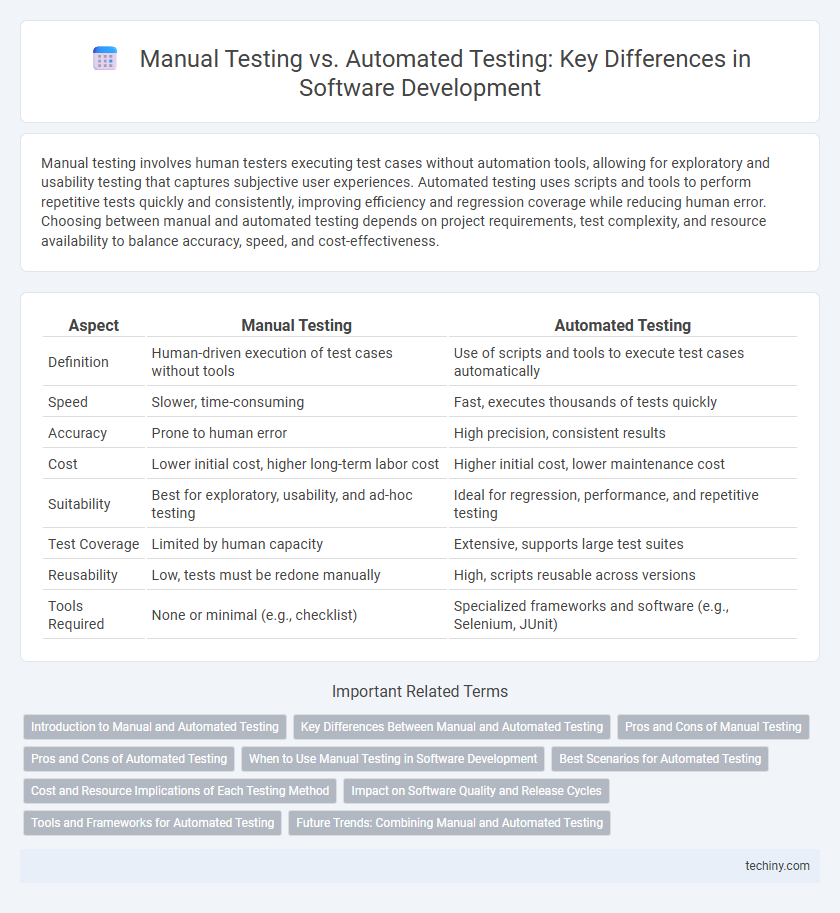Manual testing involves human testers executing test cases without automation tools, allowing for exploratory and usability testing that captures subjective user experiences. Automated testing uses scripts and tools to perform repetitive tests quickly and consistently, improving efficiency and regression coverage while reducing human error. Choosing between manual and automated testing depends on project requirements, test complexity, and resource availability to balance accuracy, speed, and cost-effectiveness.
Table of Comparison
| Aspect | Manual Testing | Automated Testing |
|---|---|---|
| Definition | Human-driven execution of test cases without tools | Use of scripts and tools to execute test cases automatically |
| Speed | Slower, time-consuming | Fast, executes thousands of tests quickly |
| Accuracy | Prone to human error | High precision, consistent results |
| Cost | Lower initial cost, higher long-term labor cost | Higher initial cost, lower maintenance cost |
| Suitability | Best for exploratory, usability, and ad-hoc testing | Ideal for regression, performance, and repetitive testing |
| Test Coverage | Limited by human capacity | Extensive, supports large test suites |
| Reusability | Low, tests must be redone manually | High, scripts reusable across versions |
| Tools Required | None or minimal (e.g., checklist) | Specialized frameworks and software (e.g., Selenium, JUnit) |
Introduction to Manual and Automated Testing
Manual testing involves human testers executing test cases without automation tools, allowing for intuitive and exploratory evaluation of software functionality. Automated testing employs scripts and testing frameworks like Selenium or JUnit to perform repeatable, high-speed test executions, enhancing efficiency and coverage. Both methods play crucial roles in quality assurance, with manual testing suited for usability and ad-hoc tests, while automation excels in regression and load testing scenarios.
Key Differences Between Manual and Automated Testing
Manual testing relies on human effort to execute test cases and identify defects, making it time-consuming and prone to human error. Automated testing uses scripts and tools to run tests efficiently, providing faster results and greater accuracy in repetitive tasks. Key differences include speed, consistency, scalability, and the initial investment required for automation frameworks compared to the low setup cost of manual testing.
Pros and Cons of Manual Testing
Manual testing allows testers to identify visual and usability issues through human observation, making it effective for exploratory and ad-hoc testing. It requires less initial setup and is flexible in handling unexpected test cases but tends to be time-consuming and prone to human error. The process lacks scalability compared to automated testing, leading to higher repetitive effort and slower regression cycles.
Pros and Cons of Automated Testing
Automated testing accelerates test execution and improves accuracy by eliminating human error, providing consistent and repeatable results essential for continuous integration and delivery pipelines. It requires significant initial investment in scripting and tool setup, demanding technical expertise and maintenance to keep test scripts up to date with evolving software. Automated tests excel in regression, load, and performance testing but may overlook user experience issues that manual testing better identifies.
When to Use Manual Testing in Software Development
Manual testing is essential when exploring new features or user interfaces to evaluate usability and identify issues that automated scripts might miss. It is most effective during early development stages and for ad-hoc, exploratory testing where human intuition and cognitive abilities play a crucial role. Manual testing also excels in validating visual elements and user experience aspects that require subjective assessment beyond predefined automation parameters.
Best Scenarios for Automated Testing
Automated testing excels in repetitive, regression, and performance testing scenarios where consistent execution and fast feedback loops are critical. It is ideal for large-scale projects requiring frequent code changes and continuous integration environments, enabling scalable test coverage with minimal human intervention. Automation tools effectively handle complex test cases that demand precision and speed beyond manual capabilities.
Cost and Resource Implications of Each Testing Method
Manual testing involves higher ongoing labor costs due to the need for skilled testers to execute test cases repeatedly, which can lead to longer project timelines and increased resource allocation. Automated testing requires an initial investment in tools and scripting, but reduces long-term expenses by enabling rapid, repeatable test execution with minimal human intervention. Organizations must weigh the upfront development cost of automation against the cumulative labor expenses of manual testing to determine the most cost-effective strategy for their software projects.
Impact on Software Quality and Release Cycles
Manual testing provides detailed human insight, uncovering nuanced user experience issues and unexpected bugs that automated tests might miss, thereby improving software quality. Automated testing accelerates release cycles by enabling rapid execution of repetitive test cases, ensuring consistent validation during continuous integration and delivery processes. Combining manual and automated testing optimizes both defect detection accuracy and release speed, enhancing overall software quality and market responsiveness.
Tools and Frameworks for Automated Testing
Popular tools and frameworks for automated testing include Selenium, Appium, and Cypress, which provide robust support for web and mobile applications. These frameworks enable efficient test script creation, execution, and integration with continuous integration pipelines, significantly reducing manual intervention. Automated testing tools also offer extensive libraries, real-time reporting, and cross-browser compatibility, enhancing test coverage and reliability compared to manual testing.
Future Trends: Combining Manual and Automated Testing
Future trends in software development emphasize a hybrid testing approach that integrates manual testing's exploratory and usability insights with automated testing's speed and repeatability. This combination enhances defect detection accuracy and accelerates release cycles by leveraging AI-driven tools that adapt test cases based on real-time analytics. Organizations adopting this synergy benefit from improved test coverage, reduced maintenance costs, and continuous quality assurance in agile development environments.
Manual Testing vs Automated Testing Infographic

 techiny.com
techiny.com